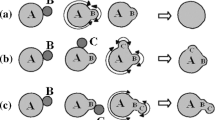Abstract
Cu nanocubes of different sizes were simulated using the Sutton–Chen molecular dynamics model. For each size, the rhombicuboctahedron shape that minimized the internal cohesive energy of the particle was chosen. Each particle’s thermodynamic properties were investigated by calculating the average potential energy per atom for each particle over temperature. The vacancy formation energy of the particles as well as the internal binding energy and surface binding energies of each particle was also characterized. The nanocube melting temperatures, surface energies indicating reactivity, and cohesive energy, indicating particle stability, were characterized and compared for different particle sizes and shapes.











Similar content being viewed by others
References
Zhao X, Luo B, Long R, Wang C, Xiong Y (2015) Composition-dependent activity of Cu–Pt alloy nanocubes for electrocatalytic CO2 reduction. J Mater Chem A 3:4134–4138
Long R, Mao K, Ye X, Yan W, Huang Y, Wang J, Fu Y, Wang X, Wu X, Xie Y, Xiong Y (2013) Surface facet of palladium nanocrystals: a key parameter to the activation of molecular oxygen for organic catalysis and cancer treatment. J Am Chem Soc 135:3200–3207
Bai Y, Long R, Wang C, Gong M, Li Y, Huang H, Xu H, Li Z, Deng M, Xiong Y (2013) Activation of specific sites on cubic nanocrystals: a new pathway for controlled epitaxial growth towards catalytic applications. J Mater Chem A 1:4228
Kohn W (1995) Density functional theory for systems of very many atoms. Int J Quant Chem 56(4):229–232
van der Walt C, Terblans JJ, Swart HC (2014) Molecular dynamics study of the temperature dependence and surface orientation dependence of the calculated vacancy formation energies of Al, Ni, Cu, Pd, Ag, and Pt. Comput Mater Sci 83:70–77
van der Walt C, Terblans JJ, Swart HC (2017) Calculated nanocube vacancy formation energy and cohesion energy at 0 K. Small. doi:10.1002/smll.201701829
Terblans JJ (2002) Calculating the bulk vacancy formation energy (Ev) for a Schottky defect in a perfect Cu(111), Cu(100) and a Cu(110) single crystal. Surf Interface Anal 33:767–770
Wang YH, Chen PL, Liu MH (2006) Synthesis of well-defined copper nanocubes by a one-pot solution process. Nanotechnology 17:6000–6006
Molecke RA (2011) Characterization, modeling, and simulation of Multiscale directed-assembly systems. Doctor of Philosophy Dissertation, The University of New Mexico Albuquerque, New Mexico
Alavi Thompson (2006) Molecular dynamics simulations of the melting of aluminum nanoparticles. J Phys Chem A 110(4):1518–1523
Sang LV, Hoang VV, Hang NTT (2013) Molecular dynamics simulation of melting of fcc Lennard-Jones nanoparticles. Eur Phys J D 67:64
Ercolessi F (1997). Time integration algorithm. http://www.fisica.uniud.it/~ercolessi/md/md/node20.html. Oct 9
Barnett RN, Landman U (1991) Surface premelting of Cu(110). Phys Rev B 44:3226
Resende FJ, Carvalho VE, Costa BV, de Castilho CMC (2004) Temperature dependent structure of low index copper surfaces studied by molecular dynamics simulation. Braz J Phys 34:414–418
Abdul-Hadi K. MSc Thesis, An-Najah National University, Palestine, 2003
Sutton AP, Chen J (1990) Long-range Finnis–Sinclair potentials. Philos Mag Lett 61:139–146
Terblans JJ, Erasmus WJ, Viljoen EC, du Plessis J (1999) Orientation dependence of the surface segregation kinetics in single crystals. Surf Interface Anal 28:70–72
Terblans JJ (2003) The calculated bulk vacancy formation energy (Ev) for a Schottky defect in Al single crystals. Surf Interface Anal 35:548–551
Hünenberger PH (2005) Thermostat algorithms for molecular dynamics simulations. Adv Polym Sci 173:105–149
Herring C (1951) Some theorems on the free energies of crystal surfaces. Phys Rev 82:87–93
TL Einstein (2015) In: Nishinaga T (ed) Handbook of crystal growth, fundamentals, 2nd edn. Elsevier, Amsterdam, ISBN 9780444563699/eBook:9780444593764), vol 1A (thermodynamics and kinetics), chap. 5, pp 215–264 (arxiv.org/pdf/1501.02213.pdf)
Acknowledgements
Thanks are due to Andrew Nash for assistance with processing data software. Special thanks are owed to Leon Wessels for his advice in programme errors and valuable discussion. One of the authors C van der Walt is grateful for funding from the Nano Cluster of the University of the Free State for bursary and running funding, and all the authors are grateful for the financial contribution from the NRF Sarchi chair (84415).
Author information
Authors and Affiliations
Corresponding authors
Ethics declarations
Conflict of interest
The authors declare that there is no conflict of interest.
Rights and permissions
About this article
Cite this article
van der Walt, C., Terblans, J.J. & Swart, H.C. Temperature- and surface orientation-dependent calculated vacancy formation energy for Cu nanocubes. J Mater Sci 53, 814–823 (2018). https://doi.org/10.1007/s10853-017-1502-y
Received:
Accepted:
Published:
Issue Date:
DOI: https://doi.org/10.1007/s10853-017-1502-y




